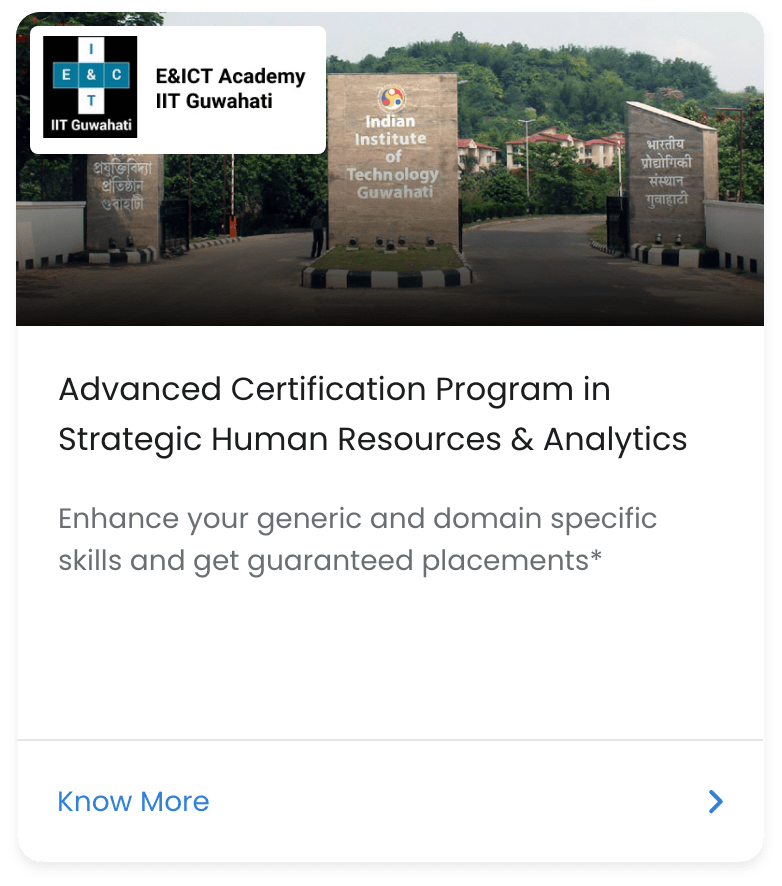Introduction
The future of Strategic Human resource management is marked by the need for HR professionals to embrace innovation, leverage technology, and anticipate emerging trends. Strategic HR leaders are required to go beyond traditional HR functions and become strategic partners who contribute to organizational success.
History of Strategic Human Resources and Analytics
Strategic Human Resource Management emerged in the 1980s as a shift from HR’s administrative focus to a strategic function. Scholars like David Ulrich emphasize the need for HR to align with business strategies and contribute to organizational success. Strategic Human Resource Management recognized human capital as a valuable asset and focused on talent acquisition, development, and creating an engaged work environment.
Click here: Join us for our FREE Webinar to advance your career in Human Resources with a pragmatic mindset.
Why the Strategic Human Resources and Analytics Domain?
- Impact on People’s Lives
- Salary Package
- Important Job Role
- Satisfying Experience
- Interaction With a Large Number of People
- Industry Growth
- Job Security
- HR Analytics in Succession Planning
Definition and Use of Strategic Human Resources and Analytics
Definition:
Strategic Human Resource Management and Analytics refers to the practice of aligning HR strategies and practices with the overall strategic objectives of an organization. It involves integrating HR considerations into the strategic decision-making process to enhance organizational performance, employee engagement, and competitive advantage.
SHRM focuses on leveraging human capital, talent management, and creating a work environment that supports the achievement of organizational goals.
Use:
Strategic Human Resource Management and Analytics is used to ensure that HR practices and initiatives are in line with the organization’s strategic direction. It involves activities such as strategic workforce planning, talent acquisition and retention strategies, performance management, leadership development, employee engagement, and culture development.
By adopting SHRM principles, organizations can optimize their human resources, attract and retain top talent, enhance employee productivity and satisfaction, and align HR efforts with long-term business success.
Significance of Strategic Human Resources and Analytics
Alignment with Organizational Goals:
Strategic HR ensures that HR practices and strategies are closely aligned with the overall objectives of the organization.
Competitive Advantage:
Strategic HR helps organizations gain a competitive edge by effectively managing and leveraging their human capital.
Talent Acquisition and Retention:
Strategic HR focuses on attracting and retaining top talent, leading to improved performance and stability.
Talent Development and Succession Planning:
Strategic HR emphasizes developing employee skills and identifying future leaders through succession planning.
Employee Engagement and Productivity:
Strategic HR creates an engaging work environment that fosters employee satisfaction and productivity.
Change Management and Adaptability:
Strategic HR enables organizations to manage change effectively and promote a culture of adaptability.
Data-Driven Decision-Making:
Strategic HR leverages HR analytics to make informed decisions and optimize HR processes.
Overall, strategic HR and Analytics align human capital strategies with organizational goals, enhance talent acquisition and retention, promote employee engagement and productivity, enable change management, and support data-driven decision-making. Its impact is seen in improved organizational performance, competitiveness, and overall success.
Click here: Join us in our FREE Webinar to advance your career in Human Resources with a pragmatic perspective.
Growth in the Strategic Human Resources and Analytics Industry over a span of 10 years:
HR Assistant/Coordinator:
Entry-level position responsible for administrative tasks such as maintaining employee records, scheduling interviews, and assisting with HR processes.
HR Generalist:
Involves a broad range of HR responsibilities, including recruitment, employee relations, benefits administration, and HR policy implementation.
HR Specialist:
Focuses on a specific area of HR, such as talent acquisition, employee training and development, compensation and benefits, or employee relations. Specialists provide expertise and guidance in their respective areas.
HR Supervisor/Team Lead:
Assumes supervisory responsibilities, overseeing a team of HR professionals and ensuring HR processes and initiatives are carried out effectively.
HR Manager:
Manages the HR function within a department or business unit. Responsible for strategic HR planning, policy development, employee engagement, and overseeing HR operations.
HR Business Partner:
Serves as a strategic partner to business leaders, aligning HR strategies with organizational goals, providing guidance on HR matters, and addressing workforce-related challenges.
HR Director:
Holds a senior leadership role, responsible for the overall HR strategy, implementation of HR initiatives, talent management, organizational development, and ensuring HR practices are aligned with business objectives.
Vice President (VP) of HR:
At this level, the role is more strategic and involves overseeing the entire HR function across the organization. The VP of HR collaborates with top executives, contributes to strategic decision-making, and drives HR initiatives that impact the organization as a whole.
Chief Human Resources Officer (CHRO):
The highest-ranking HR executive in an organization, often part of the executive team. The CHRO is responsible for setting the HR vision, driving the HR strategy, and ensuring that human capital supports the overall business objectives.
Future Trends in Strategic Human Resources and Analytics:
- Technology Integration
- Remote Work and Flexible Work Arrangements
- Focus on Employee Well-Being
- Skills Development and Belonging Learning
- Diversity, Equity, and Inclusion (DE&I)
- Strategic Workforce Planning
- Employee Engagement and Experience
- Agile HR and Change Management
Be among India’s Top 3% of Human Resources Professionals
- 24 weeks of LIVE sessions with Industry Experts
- Certification by E&ICT Academy, IIT Guwahati
Course Offerings:
- A future-paced curriculum approved by E&ICT IITG
- Top-notch training by top faculties
- Soft skills training and support
- Live Case Study Analysis
- Premium certification by E&ICT IITG
- Chance to Visit E&ICT IITG Campus
How will this certification help you stand out from the crowd?
- Helps you Showcase your dedication to the field of HR
- Demonstrates the knowledge and skills necessary to excel in the industry
- Having a certification from a prestigious institution like IIT Guwahati sets you apart from other candidates
Who will be Your faculty?
Name: Neha Mathur,
Experience of 15+ years
Alumni: Narsee Monjee Institute of Management Studies (NMIMS), Mumbai
Worked with reputed organizations like British Airways, the Guru Nanak Institute of Management Studies, and the Indian Institute of Finance and Management.
Also Read: Future of Financial Education: How Online Courses are Transforming Education
Conclusion
The future of strategic human resource management (SHRM) is promising and impactful. As organizations recognize the value of their workforce, SHRM will play a crucial role in aligning HR strategies with business goals. Key trends such as technology integration, data analytics, and a focus on employee experience will shape the future of SHRM, enabling organizations to optimize talent management, drive innovation, and create a competitive advantage in the ever-evolving business landscape.
Frequently Asked Questions
Some future trends in strategic HRM include increased use of AI and automation in HR processes, personalized employee experiences through HR technology, a shift towards agile HR practices, emphasis on employer branding and employee value proposition, focus on employee well-being and mental health support, and leveraging data analytics for predictive talent management and workforce planning.
HR analytics involves using data to gain insights and make informed decisions about HR practices. In strategic HRM, HR analytics can help organizations understand workforce trends, predict talent needs, identify skills gaps, measure the impact of HR initiatives on business outcomes, and improve decision-making in areas such as recruitment, performance management, and employee engagement.
Implementing strategic HRM can present several challenges, including resistance to change, lack of top management support, insufficient HR skills and capabilities, integrating technology into HR practices, managing a multigenerational workforce, ensuring data privacy and security, and navigating legal and ethical considerations related to HR practices.
Strategic human resource management (HRM) is the practice of aligning HR functions and activities with organizational goals and strategies. It involves integrating HR practices with overall business strategies to enhance organizational performance and create a competitive advantage through effective management of human capital.











